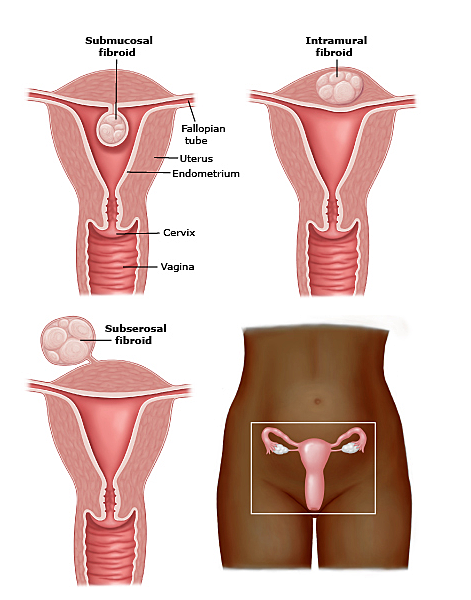Fibroid Awareness: What You Need to Know
It’s important for women to understand how uterine fibroids can affect them. Health education empowers women to act positively on behalf of their health and helps in early discovery of problems before they escalate.

By age 50, up to 80 percent of women have developed uterine fibroids. While many women don’t experience pain or symptoms from their fibroids, 25 percent will need treatment to manage their pain or heavy bleeding as a result of uterine fibroids.
Women who experience pain from their fibroids often find their quality of life affected and must seek help from their trusted medical provider. Dr. Gregory Lewis, a UF Health Jacksonville minimally invasive gynecologist surgeon, provided insight into signs, symptoms and treatment options for women who experience pain from their fibroids.
What is a fibroid?
Fibroids are benign tumors of the uterus and can range in size from as small as a seed to large enough to make a woman look pregnant. Fibroids tend to grow larger in size over time. Some women experience pain from their fibroids while others do not. Not all women with fibroids will have symptoms, as they may be found incidentally while being evaluated for something else.
What are signs or symptoms of fibroids?
Fibroids can cause prolonged and heavy bleeding during the menstrual cycle. It can also cause pelvic pressure depending on where they are located. Some people complain of urinary frequency along with constipation. Women can also experience pain in the lower abdomen area especially if the fibroids are large.
What can increase the risk of a woman having fibroids?
Typically, fibroids appear in women who are in their child bearing ages. There is a higher percentage of African American women who are affected by fibroids. Fibroid development does have a lot to do with genetics and family history.
What are the types of fibroids?
- Submucosal fibroids are fibroids that grows into the uterine cavity.
- Intramural fibroids are fibroids that grow within the wall of the uterus.
- Subserosal fibroids are fibroids that grow on the surface of the uterus
Submucosal fibroids tend to cause increased bleeding, whereas subserosal and intramural fibroids can cause more pelvic pain and pressure.
Are fibroids affected by a woman’s diet?
Generally speaking, diet is not a risk factor for fibroid development or growth. However, significant consumption of beef and other red meats in particularly have been associated with uterine fibroids. There are no dietary restrictions for women with fibroids. There’s nothing in a diet that has been proven to prevent women from getting fibroids or keep them from growing. Paying attention to a healthy diet of fruits and vegetables may be beneficial.
When should a woman seek help with her fibroids?
Women should seek help based on their symptoms. If they are experiencing pain or heavy bleeding that causes a hinderance in their daily life activities, they should speak with their gynecologist about their symptoms.
What treatments are available?
Treatment usually happens based on the size of the fibroid and what symptoms the person is showing. Treatment options are based on the woman’s reproductive goals, the size and location of the fibroids. After discussion with her gynecologist a woman can decide on a medical treatment; such as birth control (pills or Intra uterine device) or a surgical procedure.
The procedural options are recommended based on what is found during the physical or ultrasound examination . There are several types of surgical options available to treat uterine fibroids.
- Uterine embolization is a minimally invasive procedure where the blood supply to the fibroid is essentially cut off; thus, allowing the fibroid to shrink.
- Radiofrequency ablation is when energy is used to destroy the uterine fibroids.
- Laparoscopic/robotic myomectomy is surgical removal of the fibroids from the uterus. After the procedure women are typically back to work and recovered within 5-7 days.
However, it should be noted that even when fibroids are removed, they sometimes can come back. Please discuss your options with your doctor to know which works best for you.
If a patient is older and is finished with childbearing, having a hysterectomy is an option as well. This is recommended if there are multiple fibroids that have grown larger in size.
How does birth control help with symptoms of fibroids?
Birth control is an option to treat fibroid symptoms for women who experience heavier bleeding during their menstrual cycles. Birth control is really more so to help with the heavy flow and some cramping pain, but it does not shrink the fibroids or affect the size of them.
How can fibroids affect a woman trying to get pregnant?
Fibroids can’t prevent you from getting pregnant, but they can cause complications. Submucosal fibroids are the ones that can cause the most issues, sometimes associated with miscarriages. We try to either remove those type of fibroids or watch them closely. Fibroids can also cause pre-term labor. If the fibroid is really large we try to remove it before a woman is pregnant because it could lead to increased pressure and pain with both the fibroid and baby growing. Sometimes depending on the size of the fibroid it could cause the baby to be positioned abnormally. Most women find out about their fibroids before they are pregnant, but sometimes women find out about it during the pregnancy through ultrasound and we’ll monitor it in order to ensure a safe pregnancy and delivery.
Why is it important to learn about fibroids, symptoms and treatment options?
It’s important for women to understand their bodies and how uterine fibroids can affect them. Health education empowers women to act positively on behalf of their health and helps in early discovery of problems before they escalate and become too problematic. Understanding that fibroids can result in a number of issues such as excessive blood loss leading to anemia; significant abdominal pains, potential risks in pregnancy will allow women to seek early care and have relevant discussions with their doctor on the best treatment options. It is also important to have an overall understanding of how the resulting symptoms might affect one’s daily life and what resources are available.
With experts in every area of women’s health, the UF Health Obstetrics and Gynecology at Jacksonville is ideally suited to provide compassionate patient care paired with medical education and innovation. To learn more about obstetrician and gynecological services provided by UF Health Jacksonville visit UF Health Obstetrics and Gynecology.
About the author

